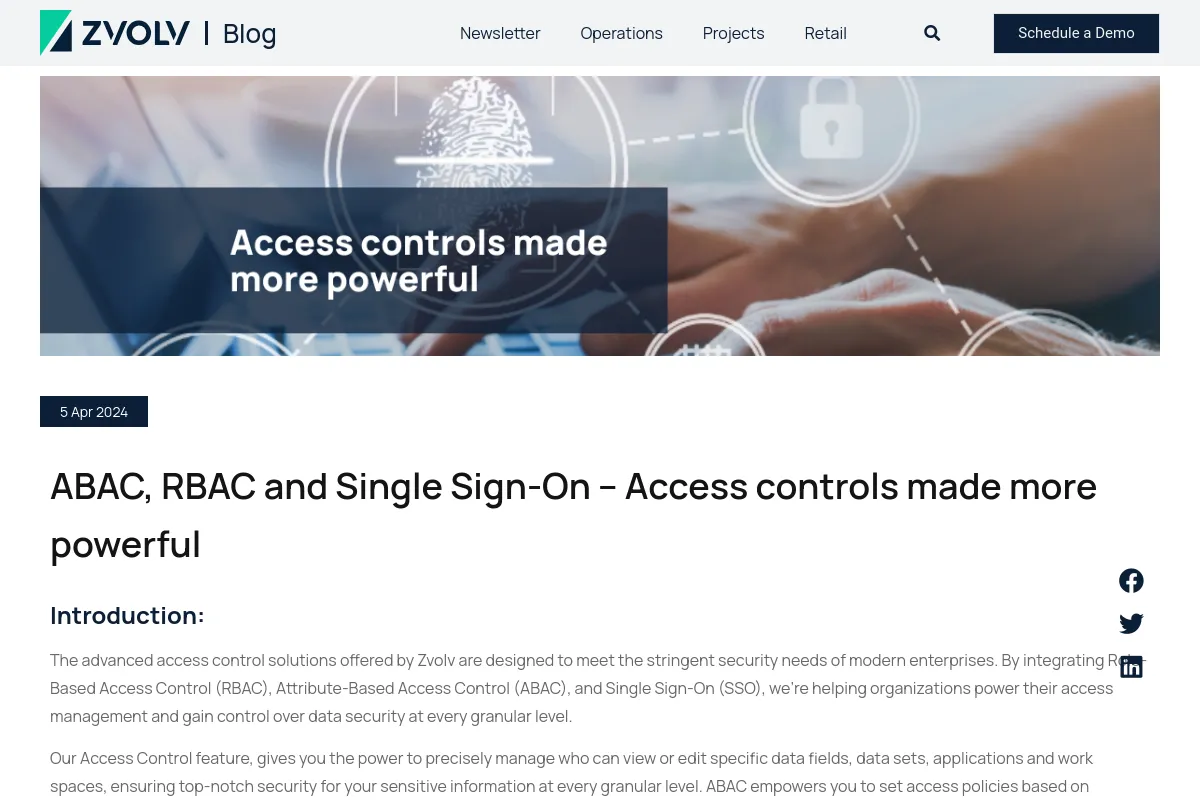ABAC, RBAC and Single Sign-On – Access controls made more powerful
Blog: Zvolv Blog
Introduction:
The advanced access control solutions offered by Zvolv are designed to meet the stringent security needs of modern enterprises. By integrating Role-Based Access Control (RBAC), Attribute-Based Access Control (ABAC), and Single Sign-On (SSO), we’re helping organizations power their access management and gain control over data security at every granular level.
Our Access Control feature, gives you the power to precisely manage who can view or edit specific data fields, data sets, applications and work spaces, ensuring top-notch security for your sensitive information at every granular level. ABAC empowers you to set access policies based on attributes, RBAC simplifies access decisions by focusing on user role or group in an organization and Single Sign-On leverages your existing organizational authentication solutions to seamlessly blend with Zvolv based applications.
Attribute-Based Access Control (ABAC):
At its core, ABAC is driven by the principle of granular access control, where access decisions are determined by evaluating various attributes associated with users, resources, and the environment. It takes a holistic view by considering a myriad of attributes such as user attributes (e.g., job title, department), resource attributes (e.g., data sensitivity, ownership), and environmental attributes (e.g., access time, location).
Benefits of ABAC:
- Granular Control: ABAC offers unparalleled granularity in access control, allowing organizations to tailor access permissions to match the specific requirements of users, resources, and business processes.
- Dynamic Adaptability: ABAC adapts to changing organizational dynamics by accommodating dynamic attributes and evolving access requirements.
- Enhanced Security: By considering a wide range of attributes, ABAC strengthens security posture by ensuring that access is granted only to authorized users under appropriate conditions, minimizing the risk of unauthorized data exposure.
Use Case:
Consider a multinational corporation with a diverse workforce spanning multiple geographic regions and functional roles. With ABAC, the organization can implement access policies that dynamically adjust based on factors such as employee location, job role, and project involvement. For example, a project manager located in Europe may be granted access to sensitive project documents only during specified working hours, while a contractor based in Asia may have limited access to financial data based on their contractual terms.
Role-Based Access Control (RBAC):
At its essence, RBAC operates on the principle of role assignment, where users are categorized into distinct roles based on their responsibilities, job functions, or organizational levels. Each role is linked to particular access permissions, defining the actions that users assigned to that role can undertake within the system.
Benefits of RBAC:
- Simplicity and Scalability: RBAC offers a straightforward and scalable approach to access management, enabling organizations to manage access permissions across large user populations and complex systems with ease.
- Enhanced Security: By aligning access permissions with predefined roles, RBAC helps organizations enforce security policies and mitigate the risk of unauthorized access or data breaches. Users are granted access only to the resources necessary for performing their job functions, reducing the attack surface and enhancing overall security posture.
- Operational Efficiency: RBAC promotes operational efficiency by simplifying access provisioning, user onboarding, and role management. Administrators can easily assign or revoke roles as users’ responsibilities evolve, ensuring that access permissions remain aligned with organizational needs.
Use Case:
Consider a healthcare organization where access to patient records is governed by strict regulatory requirements and privacy laws. With RBAC, the organization can define roles such as “Physician,” “Nurse,” and “Administrator,” each with specific access permissions tailored to the respective job functions. For example, physicians may have read and write access to patient records, while nurses may have read-only access, and administrators may have permissions to manage user accounts and system settings.
Single Sign-On (SSO):
At its core, Single Sign-On (SSO) is a centralized authentication mechanism that enables users to access multiple applications or systems using a single set of login credentials. Instead of requiring users to log in separately to each application, SSO authenticates users once and grants them access to all authorized resources without the need for repeated authentication.
Benefits of SSO:
- Improved User Experience: SSO simplifies the login process for users by eliminating the need to remember and enter multiple sets of credentials. This enhances user experience and productivity by reducing login fatigue and minimizing friction in accessing various applications and services.
- Enhanced Security: By centralizing authentication processes and enforcing consistent security policies across all integrated applications, SSO strengthens security posture and mitigates the risk of password-related vulnerabilities, such as phishing attacks and password reuse.
- Administrative Efficiency: SSO streamlines user provisioning, authentication, and access management processes for administrators by centralizing user identity management. Administrators can easily manage user accounts, access permissions, and security policies from a single centralized platform, enhancing operational efficiency and reducing administrative overhead.
Use Case:
Imagine a large enterprise with a diverse ecosystem of Zvolv applications used by employees across different departments and locations. With SSO implemented, employees can seamlessly access critical business applications and collaboration tools, using a single set of credentials. This not only simplifies the login experience for employees but also enhances security by enforcing consistent authentication policies and access controls across all integrated applications.
In conclusion, Attribute-Based Access Control (ABAC), Role-Based Access Control (RBAC), and Single Sign-On (SSO) each offer unique solutions to address the multifaceted challenges of access management and data security in today’s digital landscape. By embracing ABAC, organizations can enforce fine-grained access control based on dynamic attributes, elevating their security posture and mitigating the risk of unauthorized data exposure. Similarly, RBAC streamlines access provisioning, enforces security policies, and maintains regulatory compliance, achieving a balance between security and usability. Additionally, SSO centralizes authentication processes, enhances user experience, strengthens security posture, and improves administrative efficiency, thereby enabling organizations to achieve seamless access management and robust security measures. These solutions empower organizations to navigate the complexities of access management and safeguard sensitive information against evolving threats in the digital age.
